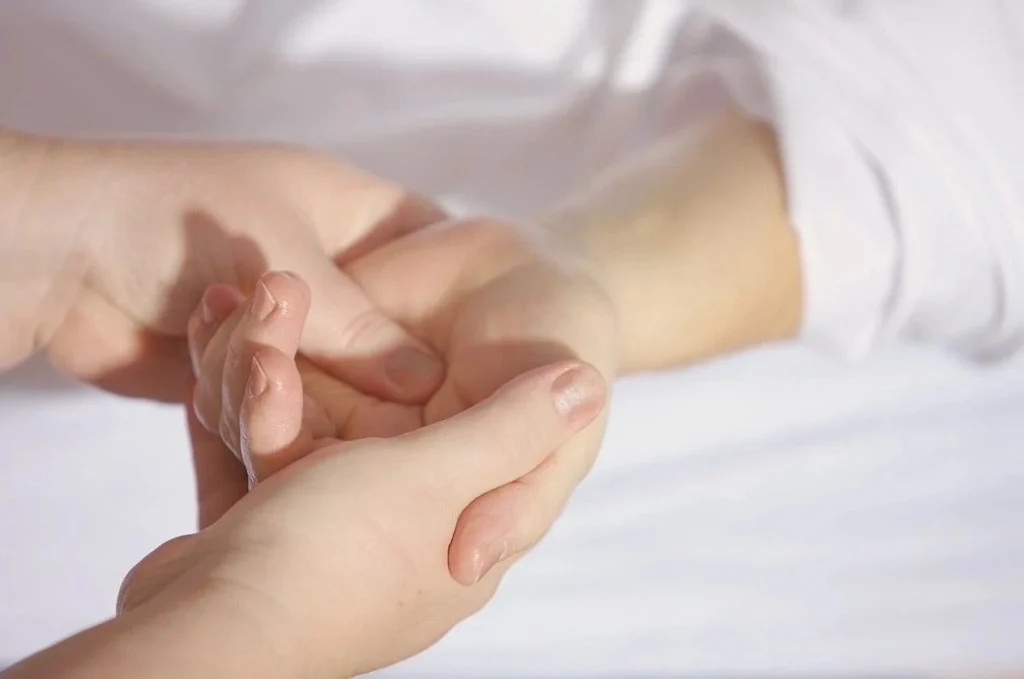Carpal tunnel syndrome (CTS) is a common affliction that may or may not be caused by the work you do with your hands. When the transverse carpal ligament becomes thicker it can compress the median nerve in the wrist, causing pain, numbness, and weakness in the hand and wrist.
Ice and heat can both prove useful for relieving carpal tunnel syndrome when used properly. Ice therapy can reduce the pressure on the median nerve, thereby helping to relieve symptoms. Heat can also help by relaxing the muscles in the hand and wrist that become tight and painful during carpal tunnel.
Ice for Carpal Tunnel
Suffering from carpal tunnel can make everyday activities painful. Even simple things can become excruciating. Driving with carpal tunnel, typing, writing, or even scrolling on your phone call all be painful.
Luckily, ice can help.
Cold temperatures can reduce pain by serving to numb the area. But, the benefits go beyond this. When you apply ice to your hand and wrist for carpal tunnel, the cold has a constricting effect. If there’s any swelling present, it goes down because the blood vessels constrict. This can also help to constrict the carpal ligament, therefore taking pressure off the median nerve.
But, this provides only temporary relief in most cases. Here’s how you can use ice on your carpal tunnel.
- Use a cold pack fresh out of the freezer, or a bag filled with ice.
- Place a towel or cloth between your skin and the ice pack to avoid damage to the skin.
- Wrap the ice pack around your wrist at the base of your hand, or use two ice packs to achieve this effect.
- Only leave the ice pack(s) on for a maximum of 20 minutes at a time. Any longer and you risk damage to the skin and nerves.
Cons of Ice for Carpal Tunnel
Many people find that, during the cold months, their carpal tunnel becomes exacerbated because too much cold can cause stiffness and pain. This is no different with ice packs. Too much will simply cause slightly different kinds of pain and stiffness in the area. That’s why it’s important to keep the ice pack on for only 20 minutes.
Ice is not a cure for carpal tunnel, but it does provide temporary relief. Unfortunately, some people come to depend on it, thinking the best they can do is manage their CTS with ice. This is not true, and we’ll get to the best ways to treat carpal tunnel below.
Ice can also be dangerous for those with cold intolerance or a condition that affects how the body perceives pain (like nerve damage).
Heat for Carpal Tunnel
Heat is helpful for carpal tunnel syndrome for different reasons. Again, it’s not about getting rid of carpal tunnel, but rather providing temporary relief so you can get on with your day.
Using heat therapy can bring blood flow and oxygen to the area, which can help the body’s healing process. It can also soothe sore and stiff muscles, which is common among people who try not to move their wrist much due to carpal tunnel.
Here’s how to use heat therapy for CTS.
- Use a heating pad or warm water.
- Place the pad around your entire wrist, or, if using water, submerge the wrist fully.
- Maintain the heat for no more than 30 minutes at a time.
Cons of Heat for Carpal Tunnel
You should never use heat therapy if your wrist is swollen or red, as it can make swelling worse. This can also happen if you leave the heat pad on for too long. Just like ice, too much heat can be a bad thing.
Heat and Ice For Carpal Tunnel
If you’ve tried heat therapy and ice therapy separately with no real relief, you may consider using them in an alternating fashion. By switching between heat and ice, you can get the best of both worlds and experience relief, and possibly even speed up the healing process.
Here’s how you do it:
- Arrange two pitchers; one with warm water (90 to 100-degrees Fahrenheit) and one with cold water (45 to 55-degrees Fahrenheit).
- Make sure you can submerge your wrist and hand in each pitcher.
- Start in the warm water, allowing your wrist to soak for two minutes, then switch to the cold water.
- Repeat this alternating action in two-minute intervals for 20 minutes.

Carpal Tunnel Pain Relief at Night
One of the big problems with carpal tunnel is that people often unconsciously bend their wrists when they sleep, exacerbating carpal tunnel. This can be hard to remedy since we don’t have much (if any) control over what we do when we’re asleep. However, there are some ways to get relief from CTS at night.
- Shake out your wrist just before bed.
- Try alternating hot and cold therapy before bed.
- Do 5 to 10 minutes of carpal tunnel exercises just before bed.
- Wear a wrist brace while you sleep.
However, like ice and heat therapy, these only address the symptoms of CTS. For proper treatment, it’s best to see a chiropractor or physical therapist.
Chiropractic and Physical Therapy for Carpal Tunnel
Since CTS is the result of a pinched nerve, chiropractors, in particular, are in an excellent position to help provide effective treatment. Chiropractic care is all about the entire musculoskeletal system, not just the spine. This is why seeing a chiropractor for carpal tunnel is a great option.
Chiropractors can help break up the scar tissue that is often the cause of CTS. This scar tissue within the wrist is not usually caused by one incident of trauma, although it’s certainly possible. Instead, scar tissue builds up over time as we do things repeatedly, like typing, working with hand tools, playing an instrument, and the like. The tissue builds up and thickens the transverse carpal ligament.
Consider a Chiropractor and Physical Therapy Office
Aside from a chiropractor, a physical therapist can also help remedy CTS. If you can find a chiropractor’s office that also offers physical therapy, you can get the best carpal tunnel treatment possible. Most, if not all, of the techniques physical therapists use to treat CTS, chiropractic offices offer, too. Things like cold laser therapy, ultrasound, and strengthening exercises are commonly used to treat CTS.
So, you can use heat and ice to relieve pain and give you relative comfort and visit a chiropractor for treatment options to get rid of the carpal tunnel.
Resources:
https://www.ncbi.nlm.nih.gov/pmc/articles/PMC4335578/
https://www.sciencedirect.com/science/article/abs/pii/S1526590015008160
https://www.sciencedirect.com/science/article/pii/S0004951414601525









